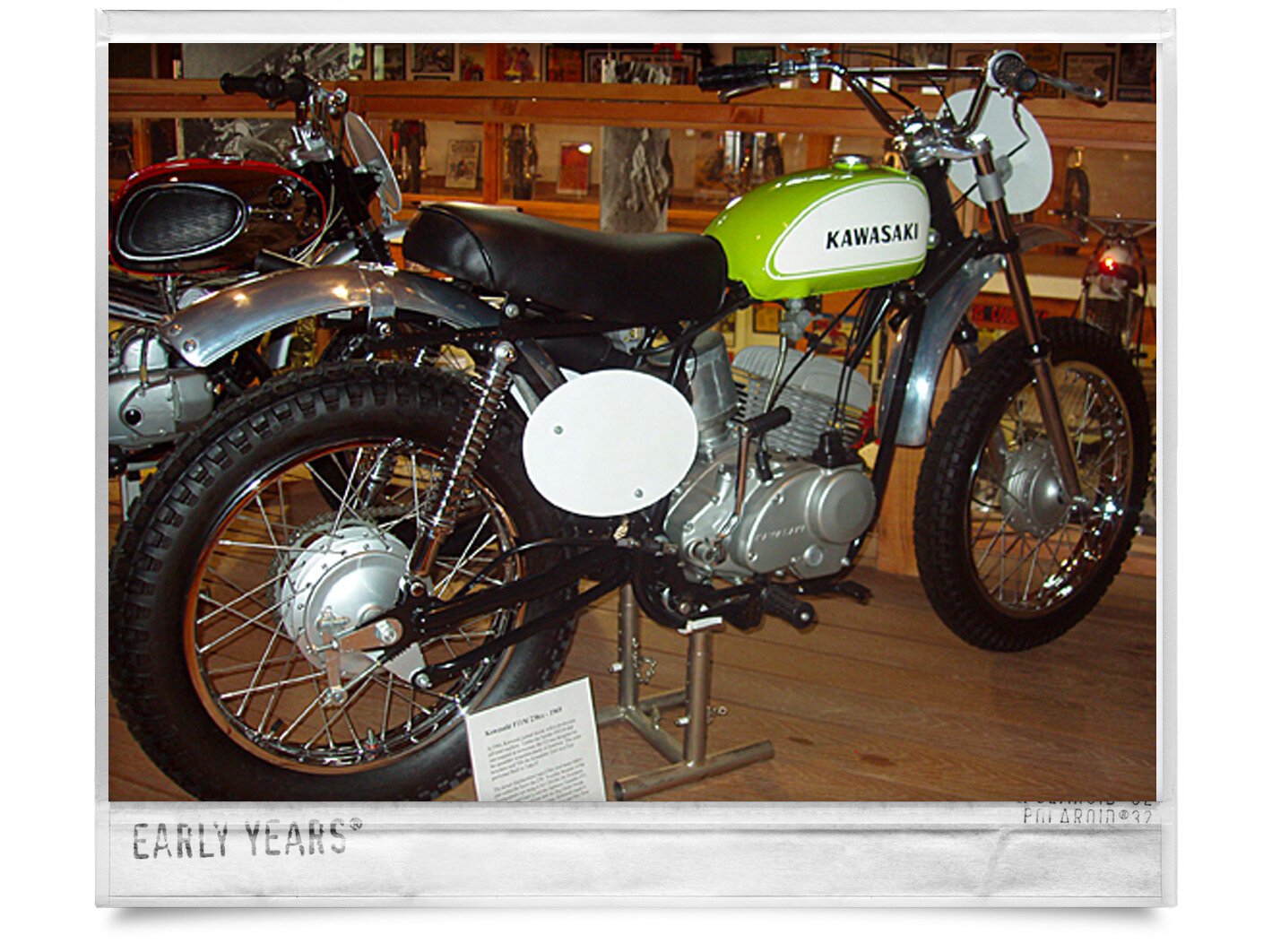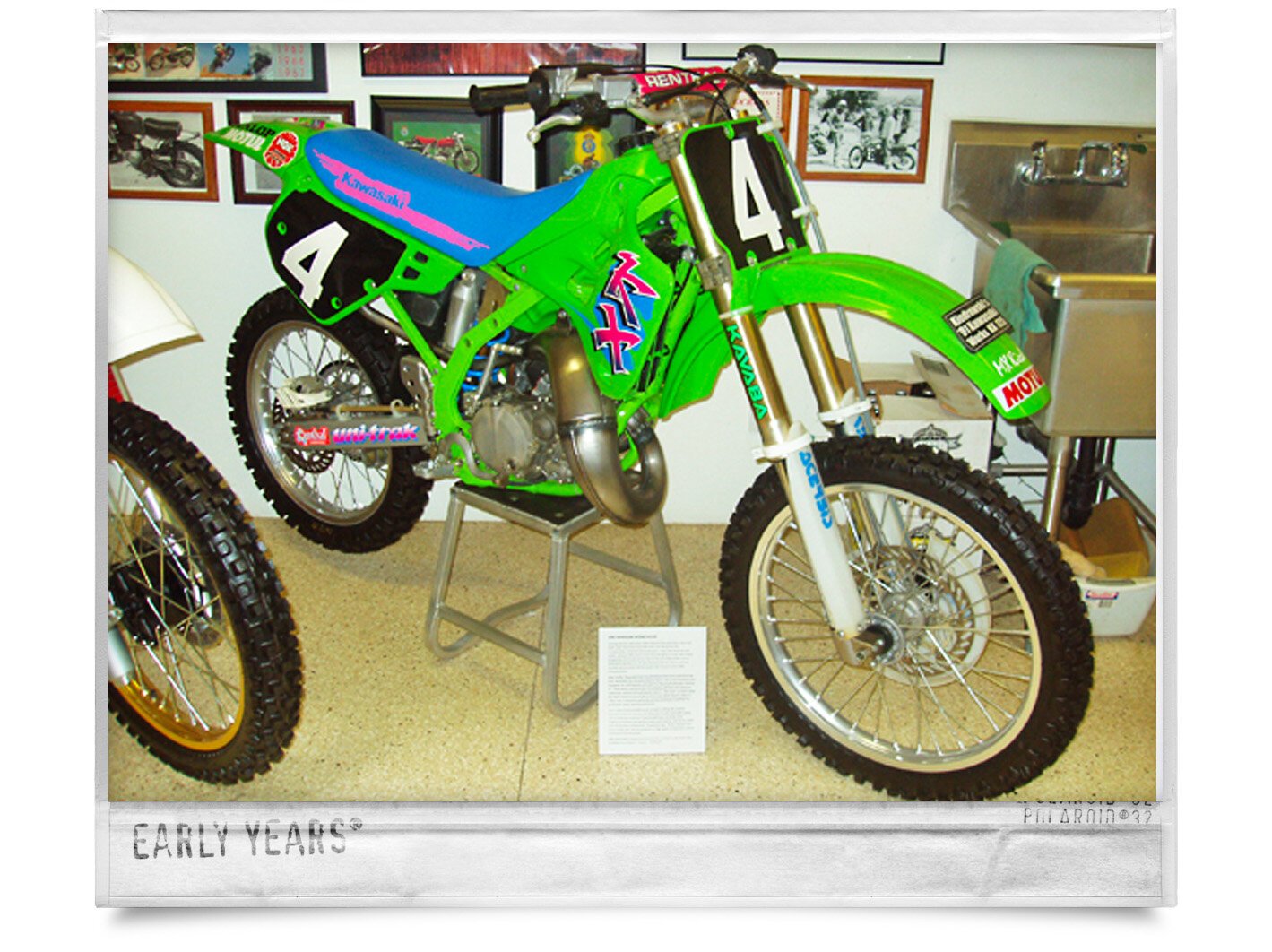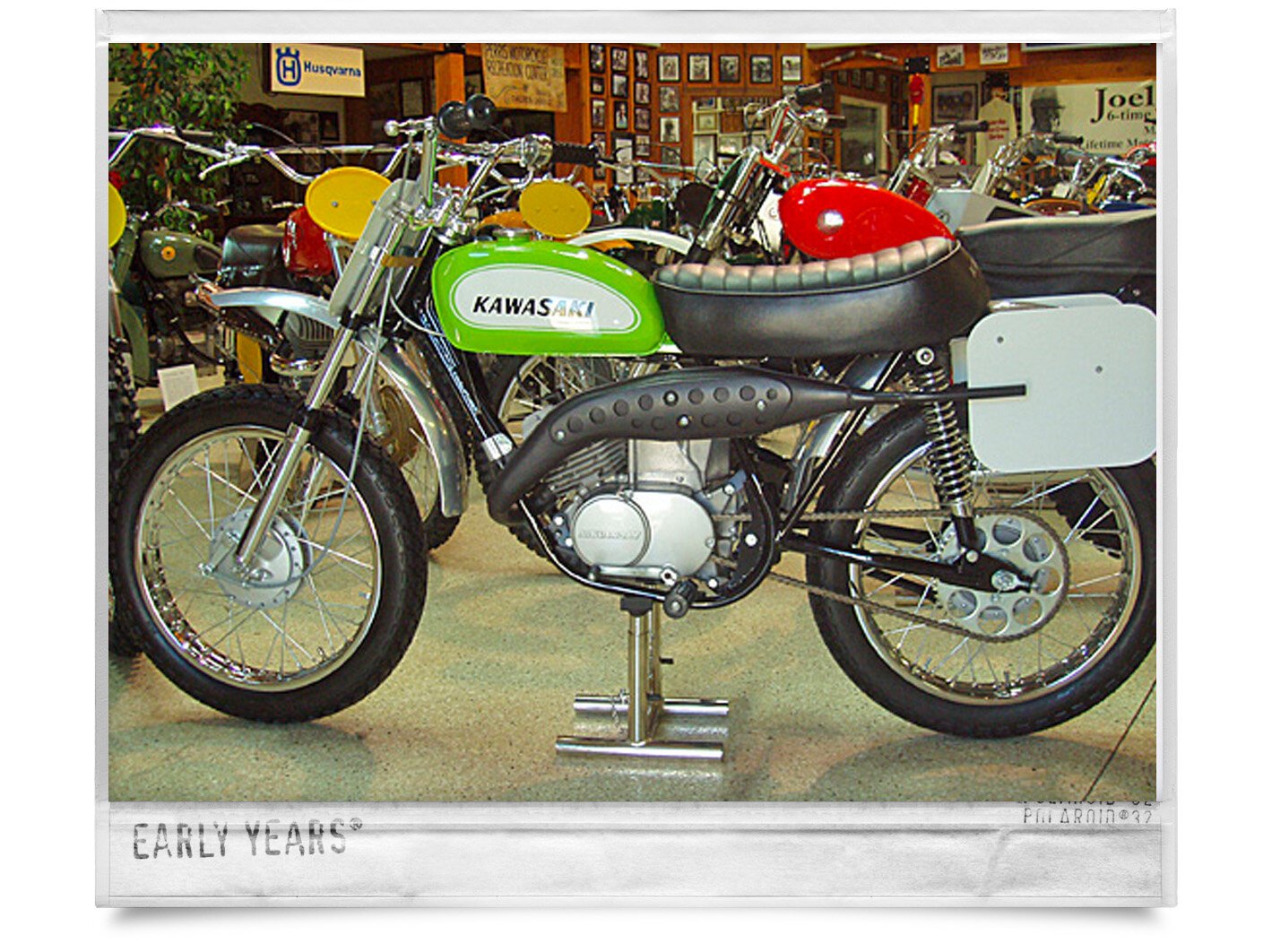Kawasaki F21M 238cc / 1969
In 1968, Kawasaki joined Suzuki with a production off-road machine. Unlike the Suzuki TM250 that was targeted at motocross, the F21was designed for the smoother scrambles tracks of America. The color brochure said “Hit the Scrambles Trail on a Top-performer Built to Take it.
The actual displacement was 238cc and many riders just called the Kawi the 238. Possibly because of the displacement not being a full 250 like the European Bultaco’s and Ossa’s, and the Japanese Yamaha DT1, performance was sub-par and the Big Green Streak never took off. At the same time, Kawasaki made a 100cc Little Green Streak that flat flew and they flew off the dealer show rooms.
The engine was rotary valve inducted with a 4-speed transmission to distribute the 30 claimed horsepower. Weight was only 215 pounds.
This bike was restored by a Kawasaki enthusiast in the Bay Area to concours condition. Enjoy!
Kawasaki F11M 250cc / 1973
By 1973 the Japanese were realizing that a warmed over trailbike wouldn’t satisfy the growing motocross market in America and around the world. Though Kawasaki had been one of the first to introduce a 250cc class motocrosser – the F21M 238cc Scrambler in 1968, the machine was best suited to the smoother scrambles tracks in America at the time. Kawasaki followed in 1971 with the Big Horn Scrambler, a physically larger and much heavier machine that would prove to be a “dust collector” in the dealer showrooms.
Motocross was also becoming popular in Japan and the Japanese 250cc National Championships were becoming an important venue to compete with the latest and greatest machines from the other Japanese manufactures. In America, Kawasaki had hired Brad Lackey to compete in the 500cc National Championships aboard a factory works bike and he rewarded them with the 1972 500cc National Championship.
In preparation for the 1973 season, the factory initiated production of a semi-production machine (just 200 units) that was dubbed the F11-M. Most of these remained in Japan as the smaller Japanese riders didn’t have the size and strength to handle the open class machines that were so popular in America.
Bryon Farnsworth – Kawasaki R&D Manager in America recalls testing the early F11M prototypes coming from Japan. “We used Peter Lamppu and Jim Cook as test riders and Kawasaki Japan contracted Thorlief Hansen! Our riders were impressed with the power, the finish was good, but suspension and handling still left something to be desired!” Bryon goes on to say, “The Japanese focused on the 250’s as their test riders were smaller and we (Kawasaki R&D in America) focused on developing the 450 identified as the F-12MX! Heck, the Japanese test riders couldn’t even start the 450’s……..we had to do it for them!”
By 1974, Kawasaki introduced the KX line of motocross bikes and later hired Jeff Ward, Gary Semics, and Jimmy Weinert to pilot the factory machines. Weinert rewarded them with a 500cc National title in 1975 and a 250cc Supercross title in 1976.
Kawasaki Works KX125 / 1991
Coming into the 1991 125cc AMA National Championships, Kawasaki hadn’t won the series since 1984 when Jeff Ward took the championship. Kawasaki was looking for a rider that could win the tiddler class and Mike Kiedrowski was looking for revenge after being dropped by the Honda factory team at the end of the 1990 season. Kiedrowski had won the ’89 125 Championship for Honda and had finished just one point behind Suzuki’s Guy Cooper in the 1990 Championships.
Mike recalls, “Kawasaki hired me with the promise and understanding that I would win the championship for them! I felt a lot of pressure, but they gave me 100% backing and built the bike exactly the way I wanted it!” Kiedrowski’s mechanic was Shane Nalley with Rick Ash doing the suspension and Jim Felt building the motors. “MX Kied” as Shane called him didn’t have the fastest bike on the track, Mitch Payton called it a “Slug,” but it suited him perfectly and they tested and modified the production based machine extensively.
Some of the engine modifications included stuffing the crank to increase crankcase pressure and filling the transfer ports with epoxy and completely reshaping. Engine weight was saving by using magnesium primary and ignition covers and shaving material on clutch and transmission components. Suspension was “Works Kayaba” and fine tuned by Ash with an emphasis on high speed compression control that Kiedrowski demanded.
Mike Kiedrowski has graciously loaned the machine to the Early Years of Motocross museum! Thanks – “MX Kied!”
Kawasaki 100cc G31M Centurian
In the early 1970s the highly tuned G31M was a dominate force in Flat Track, Tourist Trophy, and motocross events on relatively smooth tracks. The “Baby Greenstreak” as it was often called, put out an astounding 18.5 horsepower at 13,000 rpm’s. The small tip or “stinger” on the expansion chamber gave the Centurian a distinct sound that is unmistakable to this day. The engine case was slightly different than other Kawasaki’s with the G31M having a secondary air intake on the carburetor cover. It also required the use of bean oil as a fuel additive for lubrication. Even then, lower end life was short because of the engines high rpm’s.
Actor Steve McQueen was given six G31M bikes by Kawasaki for the filming of the motion picture, LeMans. McQueen kept one for himself and painted it orange with gold stripes and gave it the name “Ringadingdoo.” The bike sold at an auction held at the Petersen Museum in Los Angeles in November of 2007 for an unheard price of $55,575.




